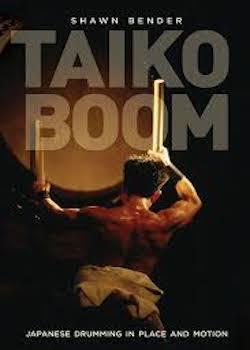Taiko Boom – Japanese drumming in place and motion

By Shawn Bender
University of California Press
2012, 280 pages
ISBN: 0520272412
Review by Mary Murata
The sound of the taiko drum is the sound of Japan. The “DON” of the huge drum booming across the temple grounds; the high pitched shime-drum as it drums out the audience from a Sumo Tournament; the cheerful beats of the festival drums accompanying bon-odori. Few traditional Japanese events would be the same without taiko in the background.
Often described as the “ancient” art of Japanese drumming, taiko has undergone a revolution since the 1950s. Taiko has moved out of the shadows, away from being the accompanying instrument in the background to centre stage. The player has become a performer skilled in not only playing the beats but also executing exciting visual physical movements. The development of the taiko ensemble owes as much to western influences as it does to traditional Japanese music. The first taiko group – Osuwa Daiko – was formed by jazz drummer Oguchi Daihachi who had the vision to create a drum kit using traditionally-made drums. The group Oedo Sukeroku evolved out of adding flash dance movements to traditional festival pieces. Ondekoza (later Kodo – arguably the most famous and best taiko group) was established by disillusioned young urbanites setting up a commune to live closer to ‘nature’. Although studying traditional music and dance, they were equally influenced by western musicality.
In his book Taiko Boom Shawn Bender charts the journey of taiko out of the temples and festivals and on to the international stage. But not only that, he uses taiko as a prism through which many aspects of Japanese society can be viewed. Asano Taiko is the world’s leading taiko drum manufacturer – established in 1609 the current owner is the 16th generation engaged in the manufacture of taiko prized across the globe. So why would the head office have a framed certificate from the tax office for “outstanding tax preparation”? The Asano family, in common with most taiko-makers, are burakumin, a group traditionally associated with “polluting” occupations such as leather work and handling dead skins (used for drum skins). Although illegal, discrimination against burakumin persists to this day. Bender takes us to Liberty – the Museum of Human Rights – in Osaka and introduces taiko groups which use taiko as way of “revealing and overcoming all forms of discrimination”.
In other chapters, Bender discusses the role of women, nationalism and aesthetics of race in taiko as well as the rise of modern “traditions.” Taiko is currently experiencing a huge increase in popularity (the titular boom) all round the world; taiko groups (Japanese and non-Japanese) regularly tour the UK, and appear on the programme at the Edinburgh festival, Glastonbury, WOMAD and the Royal Variety Performance. Despite this, very little information is available in English. Although written in a slightly academic tone (the book started life as a doctoral dissertation) it is engaging, entertaining and accessible to anyone with an interest in Japan or taiko. This fascinating book in effect doubles the number of books available in English on taiko so is a very welcome addition to the literature.

